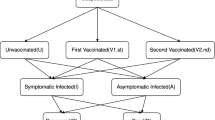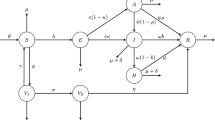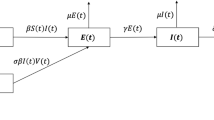Abstract
In this study, a mathematical Omicron model has been studied in view of the densities of a susceptible population without a vaccine, with the first dose of vaccine, with the second dose of vaccine and with a booster dose of vaccine respectively, at the time t. The impact of the Omicron variant virus reservoir has been analysed. The basic reproduction number (\(R_0\)) of the system at the disease-free equilibrium for all positive parameters has been discussed. An analysis of local and global stability under various conditions at disease-free and endemic equilibrium points has been conducted. The sensitivity analysis is performed and the most sensitive parameter of the system is identified. On the basis of the effect of various parameters on the system, we perform numerical simulation of the Omicron variant system in Indian population.



















Similar content being viewed by others
Data availability
All data included in this manuscript are available upon request by contacting with the corresponding author.
References
Abbasi Z, Zamani I, Mehra A, Shafieirad M, Ibeas A (2020) Optimal control design of impulsive SQEIAR epidemic models with application to covid-19. Chaos Solitons Fractals 139:110054
Adekola HA, Adekunle IA, Egberongbe HO, Onitilo SA, Abdullahi IN (2020) Mathematical modeling for infectious viral disease: the covid-19 perspective. J Public Affairs 20(4)
Alenezi MN, Al-Anzi FS, Alabdulrazzaq H (2021) Building a sensible SIR estimation model for COVID-19 outspread in Kuwait. Alex Eng J 60(3):3161–3175
Amaku M, Covas D, Bezerra Coutinho F, Azevedo Neto R, Struchiner C, Wilder-Smith A, Massad E (2021) Modelling the test, trace and quarantine strategy to control the covid-19 epidemic in the state of São Paulo, brazil. Infect Dis Model 6:46–55
Anirudh A (2020) Mathematical modeling and the transmission dynamics in predicting the Covid-19—what next in combating the pandemic. Infect Dis Model 5:366–374
Annas S, Pratama MI, Rifandi M, Sanusi W, Side S (2020) Stability analysis and numerical simulation of SEIR model for pandemic covid-19 spread in Indonesia. Chaos Solitons Fractals 139:110072
Askar S, Ghosh D, Santra P, Elsadany AA, Mahapatra G (2021) A fractional order SITR mathematical model for forecasting of transmission of covid-19 of India with lockdown effect. Results Phys 24:104067
Babajanyan S, Cheong KH (2021) Age-structured SIR model and resource growth dynamics: a COVID-19 study. Nonlinear Dyn 104(3):2853–2864
Bai Z, Zhou Y (2012) Global dynamics of an SEIRS epidemic model with periodic vaccination and seasonal contact rate. Nonlinear Anal Real World Appl 13(3):1060–1068
Bambusi D, Ponno A (2020) Linear behavior in covid19 epidemic as an effect of lockdown. J Math Ind 10(1)
Berestycki H, Roquejoffre J-M, Rossi L (2021) Propagation of epidemics along lines with fast diffusion. Bull Math Biol 83(1)
Bonnans J, Gianatti J (2020) Optimal control techniques based on infection age for the study of the covid-19 epidemic. Math Model Nat Phenom 15:48
Born B, Dietrich AM, Müller GJ (2021) The lockdown effect: a counterfactual for Sweden. PLoS One 16(4):e0249732
Carletti M, Pancrazi R (2021) Geographic negative correlation of estimated incidence between first and second waves of coronavirus disease 2019 (covid-19) in Italy. Mathematics 9(2):133
Castilho C, Gondim J, Marchesin M, Sabeti M (2020) Assessing the efficiency of different control strategies for the covid-19 epidemic. Electron J Differ Equ 2020:1–17
Castillo-Chavez C, Blower S, Driessche PVD, Kirschner DE, Yakubu A-A (2002) Mathematical approaches for emerging and reemerging infectious diseases : an introduction. Springer, Berlin
Chen T-M, Rui J, Wang Q-P, Zhao Z-Y, Cui J-A, Yin L (2020a) A mathematical model for simulating the phase-based transmissibility of a novel coronavirus. Infect Dis Poverty 9(1):1–8
Chen Y-C, Lu P-E, Chang C-S, Liu T-H (2020b) A time-dependent sir model for COVID-19 with undetectable infected persons. IEEE Trans Netw Sci Eng 7(4):3279–3294
Comunian A, Gaburro R, Giudici M (2020) Inversion of a SIR-based model: a critical analysis about the application to COVID-19 epidemic. Physica D Nonlinear Phenom 413
Cooper I, Mondal A, Antonopoulos CG (2020) A SIR model assumption for the spread of COVID-19 in different communities. Chaos Solitons Fractals 139:110057
De Sousa L, Neto P, Da Silva Filho D (2020) Kinetic Monte Carlo model for the COVID-19 epidemic: impact of mobility restriction on a COVID-19 outbreak. Phys Rev E 102(3)
Elie R, Hubert E, Turinici G (2020) Contact rate epidemic control of covid-19: an equilibrium view. Math Model Nat Phenom 15:35
Engbert R, Rabe M, Kliegl R, Reich S (2021) Sequential data assimilation of the stochastic SEIR epidemic model for regional covid-19 dynamics. Bull Math Biol 83(1)
Ershkov SV, Rachinskaya A (2021) A new approximation of mean-time trends for the second wave of covid-19 pandemic evolving in key six countries. Nonlinear Dyn 106:1433–1452
Faranda D, Alberti T (2020) Modeling the second wave of covid-19 infections in France and Italy via a stochastic SEIR model. Chaos 30(11):111101
Fitzgibbon W, Morgan J, Webb G, Wu Y (2020) Analysis of a reaction-diffusion epidemic model with asymptomatic transmission. J Biol Syst 28(3):561–587
Ghanbari B (2020) On forecasting the spread of the covid-19 in Iran: the second wave. Chaos Solitons Fractals 140:110176
Glass DH (2020) European and us lockdowns and second waves during the covid-19 pandemic. Math Biosci 330:108472
He S, Peng Y, Sun K (2020) SEIR modeling of the COVID-19 and its dynamics. Nonlinear Dyn 101(3):1667–1680
Hu J, Hu G, Cai J, Xu L, Wang Q (2021) Hospital bed allocation strategy based on queuing theory during the covid-19 epidemic. Comput Mater Contin 66(1):793–803
James N, Menzies M, Radchenko P (2021) Covid-19 second wave mortality in Europe and the United States. Chaos 31(3):031105
Jiao S, Huang M (2020) An SIHR epidemic model of the Covid-19 with general population-size dependent contact rate. AIMS Math 5(6):6714–6725
Kantner M, Koprucki T (2020) Beyond just “flattening the curve”: optimal control of epidemics with purely non-pharmaceutical interventions. J Math Ind 10(1)
Khyar O, Allali K (2020) Global dynamics of a multi-strain SEIR epidemic model with general incidence rates: application to covid-19 pandemic. Nonlinear Dyn 102(1):489–509
Kot M (2001) Elements of mathematical ecology. Cambridge University Press, Cambridge
Kudryashov NA, Chmykhov MA, Vigdorowitsch M (2021) Analytical features of the SIR model and their applications to COVID-19. Appl Math Model 90:466–473
Kumar RP, Basu S, Santra P, Ghosh D, Mahapatra G (2022) Optimal control design incorporating vaccination and treatment on six compartment pandemic dynamical system. Results Control Optim 7:100115
Lahrouz A, Omari L, Kiouach D, Belmaâti A (2012) Complete global stability for an SIRS epidemic model with generalized non-linear incidence and vaccination. Appl Math Comput 218(11):6519–6525
Liu Z, Magal P, Seydi O, Webb G (2020) Predicting the cumulative number of cases for the COVID-19 epidemic in China from early data. Math Biosci Eng 17(4):3040–3051
Liu Z, Magal P, Webb G (2021) Predicting the number of reported and unreported cases for the COVID-19 epidemics in China, South Korea, Italy, France, Germany and United Kingdom. J Theor Biol 509:110501
Mahato S, Pal S, Ghosh KG (2020) Effect of lockdown amid covid-19 pandemic on air quality of the megacity Delhi, India. Sci Total Environ 730:139086
Maheshwari H, Yadav D, Chandra U, Rai D (2020) Forecasting epidemic spread of COVID-19 in India using arima model and effectiveness of lockdown. Adv Math Sci J 9(6):3417–3430
Mumbu ARJ, Hugo AK (2020) Mathematical modelling on COVID-19 transmission impacts with preventive measures: a case study of Tanzania. J Biol Dyn 14(1):748–766
Nie L, Guo X, Yi C, Wang R (2020) Analyzing the effects of public interventions on reducing public gatherings in China during the COVID-19 epidemic via mobile terminals positioning data. Math Biosci Eng 17(5):4875–4890
Oud MAA, Ali A, Alrabaiah H, Ullah S, Khan MA, Islam S (2021) A fractional order mathematical model for covid-19 dynamics with quarantine, isolation, and environmental viral load. Adv Differ Equ 2021(1):1–19
Parag K, Donnelly C (2020) Using information theory to optimise epidemic models for real-time prediction and estimation. PLoS Comput Biol 16(7)
Pedro SA, Ndjomatchoua FT, Jentsch P, Tchuenche JM, Anand M, Bauch CT (2020) Conditions for a second wave of covid-19 due to interactions between disease dynamics and social processes. Front Phys 8:428
Prem Kumar R, Basu S, Ghosh D, Santra PK, Mahapatra G (2021) Dynamical analysis of novel covid-19 epidemic model with non-monotonic incidence function. J Public Affairs, e2754
Rezapour S, Mohammadi H, Samei M (2020) SEIR epidemic model for COVID-19 transmission by Caputo derivative of fractional order. Adv Differ Equ 2020(1)
Rihan F, Alsakaji H, Rajivganthi C (2020) Stochastic SIRC epidemic model with time-delay for COVID-19. Adv Differ Equ 2020(1)
Sahoo BK, Sapra BK (2020a) A data driven epidemic model to analyse the lockdown effect and predict the course of COVID-19 progress in India. Chaos Solitons Fractals 139:110034
Sahoo B, Sapra B (2020b) A data driven epidemic model to analyse the lockdown effect and predict the course of covid-19 progress in India. Chaos Solitons Fractals 139
Sardar T, Nadim SS, Rana S, Chattopadhyay J (2020) Assessment of lockdown effect in some states and overall India: a predictive mathematical study on covid-19 outbreak. Chaos Solitons Fractals 139:110078
Singh P, Gupta A (2021) Generalized SIR (GSIR) epidemic model: an improved framework for the predictive monitoring of covid-19 pandemic. ISA Transactions
Sun C, Hsieh Y-H (2010) Global analysis of an SEIR model with varying population size and vaccination. Appl Math Model 34(10):2685–2697
Wang L, Zhang X, Liu Z (2018) An SEIR epidemic model with relapse and general nonlinear incidence rate with application to media impact. Qual Theory Dyn Syst 17(2):309–329
Wang K, Lu Z, Wang X, Li H, Li H, Lin D, Cai Y, Feng X, Song Y, Feng Z, Ji W, Wang X, Yin Y, Wang L, Peng Z (2020) Current trends and future prediction of novel coronavirus disease (COVID-19) epidemic in China: a dynamical modeling analysis. Math Biosci Eng 17(4):3052–3061
Wintachai P, Prathom K (2021) Stability analysis of SEIR model related to efficiency of vaccines for covid-19 situation. Heliyon 7(4):e06812
World Health Organization (2021) Update on omicron. https://www.who.int/news/item/28-11-2021-update-on-omicron
Yan Q, Tang Y, Yan D, Wang J, Yang L, Yang X, Tang S (2020) Impact of media reports on the early spread of COVID-19 epidemic. J Theor Biol 502:110385
Yang W, Sun C, Arino J (2010) Global analysis for a general epidemiological model with vaccination and varying population. J Math Anal Appl 372(1):208–223
Yang Q, Yi C, Vajdi A, Cohnstaedt L, Wu H, Guo X, Scoglio C (2020) Short-term forecasts and long-term mitigation evaluations for the covid-19 epidemic in Hubei province, china. Infect Dis Model 5:563–574
Zhao S, Chen H (2020) Modeling the epidemic dynamics and control of covid-19 outbreak in china. Quant Biol 8(1):11–19
Zhou X, Cui J (2011) Analysis of stability and bifurcation for an SEIR epidemic model with saturated recovery rate. Commun Nonlinear Sci Numer Simul 16(11):4438–4450
Acknowledgements
The authors extend their appreciation to the Prince Sattam bin Abdulaziz University for supported this study. The authors also would like to thank the Editor and anonymous Reviewers for their useful suggestions and comments which further enhanced this work.
Funding
This study is supported via funding from Prince Sattam bin Abdulaziz University project number (PSAU/2023/R/1444).
Author information
Authors and Affiliations
Corresponding author
Ethics declarations
Conflict of interest
The authors declare that they have no conflict of interest.
Ethical approval
This article does not contain any studies with human participants or animals performed by any of the authors.
Additional information
Publisher's Note
Springer Nature remains neutral with regard to jurisdictional claims in published maps and institutional affiliations.
Rights and permissions
Springer Nature or its licensor (e.g. a society or other partner) holds exclusive rights to this article under a publishing agreement with the author(s) or other rightsholder(s); author self-archiving of the accepted manuscript version of this article is solely governed by the terms of such publishing agreement and applicable law.
About this article
Cite this article
Prem Kumar, R., Basu, S., Santra, P.K. et al. Global stability and sensitivity analysis of parameters of Omicron variant epidemic in diverse susceptible classes incorporating vaccination stages. Soft Comput 28, 4689–4713 (2024). https://doi.org/10.1007/s00500-023-09170-0
Accepted:
Published:
Issue Date:
DOI: https://doi.org/10.1007/s00500-023-09170-0




